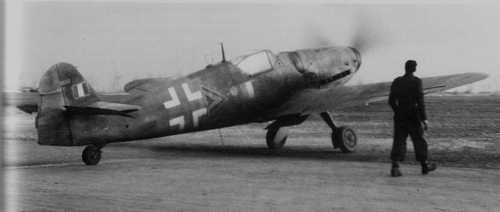
Italian Forces
The ANR’s Bf 109s
Northern Italy, 1944 or 1945: a Messerschmitt Bf 109G-10 of ANR-Aeronautica Nazionale Repubblicana’s 2nd Gruppo leave the dispersal to go for take-off. The ANR’s 2nd Gruppo Caccia (Fighter Group) was the first air unit of the Repubblica Sociale Italiana - the Republic founded on Autumn 1943 by Mussolini after his return in Italy from the Germany – equipped with the Messerschmitt Bf 109. Starting from first half 1944, the ANR was, after the Regia Aeronautica on 1943, the second Italian user of the German fighter receiving directly by the Luftwaffe about 200 Bf 109, all of Series G-6 and G-10, except three K-4 and at least two G-12 two-seat trainer, as replacement of the Macchi MC.205 and Fiat G.55 now barely available because war attrition and the nearly total destruction of the Italian aeronautical factories by the Allied raids. The 2nd Gruppo was established at Bresso airfield, Milan, on January 1944, leader Tenente Colonnello (Lt. Col.) Aldo Alessandrini, with Squadriglie: 1st “Gigi Tre Osei” (Luigi Three Bird, in Italian “Gigi” is the Luigi’s diminutive), leader Tenente (Lt.) Ugo Drago; 2nd “Diavoli Rossi” (Red Devils), leader Capitano (Capt.) Mario Bellagambi; 3rd “Gamba di ferro” (Iron Leg), leader Capitano (Capt.) Luccardi. After a brief operational activity with the G.55, the 2nd Gruppo began at Cascina Vaga, near Pavia, the transition to Bf 109 at Cascina Vaga, near Pavia, and the familiarization with the German combat tactics and soon was completely operative with the German fighter accomplishing interdiction missions and scramble under radar control of the Luftwaffe’s Jagdführer based near Verona. Later the 2nd Gruppo was based in the North East Italy with the Squadriglie 1st and 3rd at Verona-Villafranca and Aviano and the 2nd Squadriglia at Osoppo (Udine) and Bergamo-Orio al Serio. Other airfield used was Lonate Pozzolo, near Varese, and Thiene (Vicenza). Early March 1945 the new Gruppo’s leader was the Maggiore (Squadron Leader) Carlo Miani. On 26 April 1945, few days before the Germany’s surrender in Italy, the strength of the 2nd Gruppo, Orio al Serio, was 26 Bf 109. The other ANR’s Gruppo with the German fighter was the 1st Gruppo Caccia, Squadron Leader Maggiore Adriano Visconti, Squadriglie 1st “Asso di Bastoni” (Ace of Clubs), 2nd “Vespa Arrabbiata” (Angry Wasp) and 3rd “Archiere” (Archer), which late October 1944 moved to Bavaria, at Holzkirchen, for training to Bf 109. On January 1945 the Gruppo returned in Italy and based to Lonate Pozzolo. On March 1945 was completely operative with the German fighter. The last ANR’s unit planned for the Bf 109 was the 3rd Gruppo Caccia "Francesco Baracca" established on 11 August 1944 with a Squadriglia at Vicenza and the other two at Thiene (near Vicenza). In reality this Gruppo, without airplanes, was never operative. Early January 1945 some pilots moved to Holzkirchen, but their training began only on February. End March the pilots returned in Italy, but by now the Bf 109s available for the Italians running out and only an aircraft was delivered. On 20 April two Bf 109 planned for the 3rd Gruppo was switched to 2nd Gruppo as replacement of losses and the same happened for a third Bf 109 departed from Holzkirchen on 21 April 1945. The lone 3rd Gruppo’s Bf 109 was destroyed by the unit’s personnel at the moment of the surrender. Victor Sierra
5817 Views
4/6/2013
